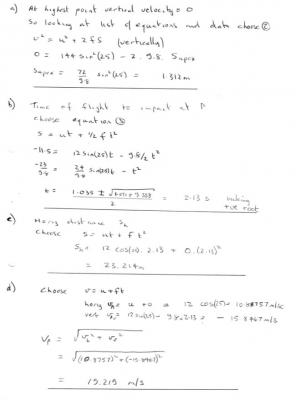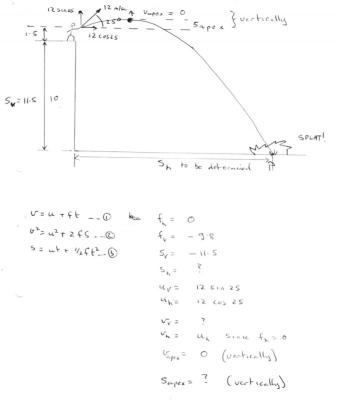-
Posts
18482 -
Joined
-
Last visited
-
Days Won
108
Everything posted by studiot
-
In DP debates It is often pointed out the the DP does not form an effective deterrent. That is over a long period the statistics show that the murder rate remains the same with it or without it. Here is a quote from a novel I have been reading about the hunt for a particularly unpleasant serial killer. Today we have learned that the French discontinued surveillance of the perpetrators of the Charlie Hebdo massacre about six months ago. There are good people in France, needing help medical or otherwise, that there was no money to help whilst at the same time expensive resources were being spent of surveillance and finally combating such monsters. Let the discussion commence.
-
Billiards Hmm let me see. arc proposed an expanding Earth, powered by electrodynamic action, in order to explain observed effects. and you acknowledged this. That is a chain of two separate sequential propositions and one set of results. That entails two steps to heaven. I stated that arc has suspended step 1 so that we can examine if step 2 would actually work as proposed. And you have been berating me for that statement, in most intemperate language, ever since. Would we be any more able to get to heaven if we followed steps 1 2 and 3?
-

Should we change the forum's name to Religous Forums ?
studiot replied to studiot's topic in The Lounge
If you guys keep using the wrong code I will have to send the man with the WaltherPPK to shoot you. -
Would this be homework?
-

Should we change the forum's name to Religous Forums ?
studiot replied to studiot's topic in The Lounge
我不明白中國人。你能不能用英語寫的?謝謝 Nah, the correct response is ######################### See Bletchly Park for details. -
Who hasn't been following closely? Page 1, post 1 lines 1-4. Clearly I was correct. As regards mantle convection And I refuted your underlined statement. Both subduction and mantle convection are possible without the other. It is entirely possible for one of two impacting plates to ride over the other, which is a definition of subduction. However without mantle convection another mechanism would be required to cause the horizontal advection of the plates in the first place. We are examining arc's speculation that such a mechanism could be radial expansion. It is worth noting that mantle convection does not require segments of colder more dense lithosphere to descend, in order to take place. Mantle material falls within the Raleigh criterion for such convection to occur, but we cannot expect arc to solve as even the simplest equations to derive this lead to a sixth order differential equation. Agreed arc's speculation requires core expansion, but that requires an energy source and we are setting aside the original proposal for the moment to examine if it is worth continuing since unless the speculation can be shown to produce the surface dynamics there is no point seeking an alternative energy source.
-

Should we change the forum's name to Religous Forums ?
studiot replied to studiot's topic in The Lounge
I'm glad everyone's enjoying my thread. But please remember that I did not suggest a total ban on non-science, just commented on the relative proportions. -
Get a hold of The Chemistry Maths Book Erich Steiner Oxford University Press. This is easier than maths for physics but will take you a long way towards what you need. There are several editions, you don't need a new copy, pretty well any version will do.
-
Scotch or 3M had lots of egg on their faces in the heyday of cassette tapes when they introduced a super chrome tape that did exactly this. But that was years ago. What brand are they?
-

Should we change the forum's name to Religous Forums ?
studiot replied to studiot's topic in The Lounge
IEeeeeeee Who is he? -
I have been investigating this because capillary water in plants does ooze out if you cut them. I think the answer is evaporation. The water evaporates at the free surface, drawing more water up behind it. But note that the capillary pathways in plants are esentially very small bore. So either the quantity transprted is small or there are a great many pathways as in a large tree.
-
One difference between siphonic and other air pressure base devices and capillary action is that air pressure devices are independent of the bore of the pipe. Capillary devices become progressively less efficient as the pipe bore increases, until they don't work at all. Of course the smaller the bore the smaller the flow.
-
So why the first line of post#1?
-
Sorry, I should have mentioned before. The diagram in post#1 shows an attempt at a siphon, which works due to external (to the fluid) pressure difference. Capillary action works due to (internal) fluid surface tension.
-
So elaborate? The OP mentions 32 feet, which implies water to me and therefore temperatures between 0o and 100oC. Adding polyethylene oxide provides an interesting diversion, but the outlet is still below the inlet. https://www.youtube.com/watch?v=s_3DP3QYqos
-
arc, Good luck. Billiards, Mantle convection is not contingent upon subduction and would occur without the presence of any plates. arc has indeed listened to others in this thread and modified his hypotheses as a result. For instance the original proposal was that the energy comes from a dynamo effeect of the Earth's core sweeping round in the Sun's magnetic field. Addressing the source of energy has not been resolved since that was abandoned, but the new proposal seems to be gravitational. Surely this process is exactly what we want to see at SF (and elsewhere in the scientific community) The testing of ideas against observation and existing knowledge (theory).
-
I wonder if the person who gave the -1 point (undeserved IMHO) to a new member who appears to be trying hard can actually state why the above proposed arrangement will not work? Hanscheti, Firstly thank you for taking note of my request not to blur the text +1 You have attempted to show a siphon but clearly don't understand the basics so I really suggest you take a basic physics course if you wish to emulate the achievements of your great countryman Bose. A syphon will only work if the outlet is below the inlet so trying to raise water with one will not work in the manner you have shown. Once again I urge you to study some basic physics before trying what we call a wild goose chase for a perpetual motion machine you will not find one. https://www.youtube.com/watch?v=CZmP0vsRBZ8
-
None of that could happen if my favoured option "The no party system" was adopted. This operated successfully in Britain from about AD 500 to AD 1066 as the Witan.
-
Amongst all the Romans, Greeks and other foreigners (no offence meant) using? the phrase Wiki mahaged to dig up one Briton. Yet it proudly blazons "principly used in the United kingdom" Poppycock Now that is a real British word. http://www.urbandictionary.com/define.php?term=poppycock
-

Recommended reading materials?
studiot replied to andrewcellini's topic in Biochemistry and Molecular Biology
It's difficult to recommend older books as this is a rapidly developing subject but the following are good value Apps et al http://www.amazon.co.uk/s/ref=nb_sb_noss?url=search-alias%3Dstripbooks&field-keywords=apps+biochemistry Downes http://www.amazon.co.uk/chemistry-living-cells-Helen-Downes/dp/B0006AXMQS Stryer http://www.amazon.co.uk/s/ref=nb_sb_noss_2?url=search-alias%3Dstripbooks&field-keywords=stryer+biochemistry%23 Baldwin books. The nature of biochemistry is old but good. http://www.amazon.co.uk/s/ref=nb_sb_noss?url=search-alias%3Dstripbooks&field-keywords=baldwin+biochemistry&rh=n%3A266239%2Ck%3Abaldwin+biochemistry&ajr=1 Rose http://www.amazon.co.uk/s/ref=nb_sb_noss?url=search-alias%3Dstripbooks&field-keywords=baldwin+biochemistry&rh=n%3A266239%2Ck%3Abaldwin+biochemistry&ajr=1#/ref=nb_sb_noss?url=search-alias%3Dstripbooks&field-keywords=rose+chemistry+of+life&rh=n%3A266239%2Ck%3Arose+chemistry+of+life -
Here you have the classic situation of a common or garden English word being given a specific meaning for use in one or more scientific disciplines. It is important not to mix these meanings and use the appropriate one in the appropriate place. Most scientific uses stress the low rainfall, English use stresses the emptiness. What would you call a high rainfall land area that was in a warm part of the globe, but (almost or completely) devoid of vegetation?
-
Hi, I hope your exam went well. Now that it is over and since there seems to be some question as to the numerical answers, I can post my full solution. Note that the actual numbers will depend upon the value taken for g. I have used g = 9.8 since it make no difference to a calculator. For hand calculation it is often a good dodge to use g =10. As I recommended I have drawn a diagram, showing all the information given. I also recommend writing down all the equations of motion and assembling a list of the known and unknown data. You can then look at the list and see which equation has only one unknown to use. I have done this in the first attachment. and followed my own advice in the second. I wonder, perhaps if you miscopied the original height and time of flight. Note also the correct use of negative quantities.
-
Good morning arc, gosh it's wet and windy here today. No I am not making fun, just trying to help. Your idea, right or wrong, should be properly considered because it is a good one. If it eventually fails it will not be because of plausibility but because things just didn't happen that way. I see you are now on line so am posting this encouragement quickly and will post something more considered later. PS I have no idea what Billiards meant.
-
It is a not a good idea to blur the text like that some of us can hardly read it. No it will not be able to generate electricity, but you might be able to contrive to keep the liquid in the J shape using electricity.
-
Good morning The difference, as I see it, is that you have produced an interesting (speculative) theory, whilst I can claim none at all. If your theory can be made potentially viable it can proceed to the next stage of testing against observation. Yes indeed, that is what we are doing. I think it is important to be clear as to the distinction between Force, Stress and Pressure, which are different physical quantities, though very closely linked. Other important mechanical considerations are the difference between a solid and a fluid and that of a confined v unconfined fluid or body. Finally the important idea that an unconfined body suffers no stress on thermal expansion. It is interesting that you think the radius of the Earth cannot be measured with sifficient accuracy, yet you think that the weight of a separated segment of crust can cause a measurable increase in magma pressure. I would have said it is the other way round. Particularly as this is your thesis. That the magma pressure is the result of attempted thermal expansion against confinement. Also technology achieved the ability to measure the 'radius' of the Earth to millimetric accuracy in about the 1880s, and we can do much better today. However, something else to consider. Geodesists do not talk of the 'radius' of the Earth as to a particular physical surface. Measurements are made in relation to gravitational equipotential surfaces. So when you invoke gravity you need to consider movement measured against these surfaces, which may not be constant. So when you talk about uplift ask uplift measured against what? Did the local gravity surfaces change as well as the topographical ones? This is a huge task, but Everest 'discovered' the Himalayas because of gravitational anomalies affecting his results.



